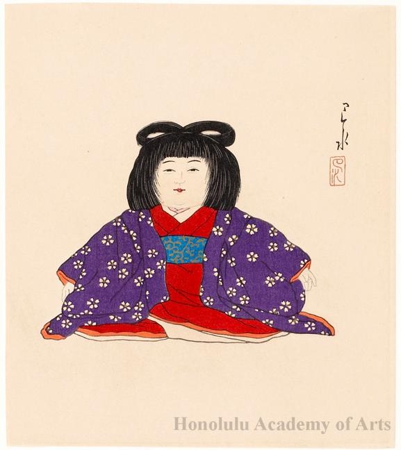Ishö Ningyö (Costume Doll)
Artist: Kawase Hasui
Name: Ishö Ningyö (Costume Doll)
Date: c. 1930
Source: Honolulu Museum of Art
Description: This print is a part of a rare edition of twenty-four prints of Japanese palace dolls (Gosho ningyö), issued as a set, which Hasui designed sometime around 1930. The binding for the set bears a title in English, and the prints are accompanied by a preface in English by the well-known print designer and President of the Japanese Woodcut Print Society, Okada Saburösuke (1869-1939). From Okada’s preface, it is clear that this edition was directed specifically at the overseas market, and was intended to promote foreign interest in Japanese prints. Unlike the kuchi-e and other popular prints in this exhibition, Hasui’s set was made as a limited edition that used the finest paper and pigments, with careful monitoring of the printing process to assure that only the best quality prints were issued. Hasui’s doll designs are simpler than the landscape prints for which he is best known, but the superb printing, gem-like colors, and luxurious paper make these among his most exquisite works. (from Four Generations of J-Woodblock prints exhibition 11/7/2007-) Palace dolls usually depict healthy toddlers. Carved from paulownia wood, the surface has several thin layers of applied white paint (gofun), made from powdered oyster shell and glue. This technique, originally introduced to Japan as a Buddhist sculpting method, was imported from China in the Muromachi period (1392 – 1573). (from “Doll! Doll! Doll! / Kawase Hasui” exhibition, 2/14/2003- )


